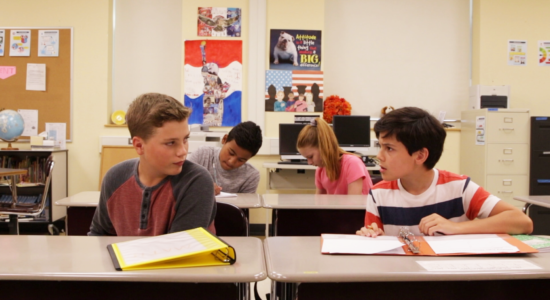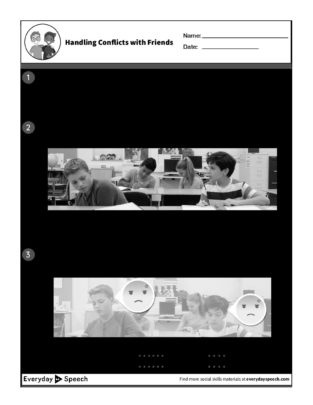Try the no-prep way to teach Handling Conflicts With Friends
Take the prepwork out of teaching essential social-emotional skills with Everyday Speech! Subscribe to access step-by-step curriculum and over 1,000 videos, games, and more.

Preview an SEL skills lesson: Handling Conflicts With Friends

00:00:11.970 –> 00:00:15.765
Disagreements or arguments with friends
are called Conflicts.
00:00:23.132 –> 00:00:25.843
Conflicts with friends
can happen from time to time
00:00:25.868 –> 00:00:28.625
and may make us feel upset
or uncomfortable.
00:00:32.141 –> 00:00:35.751
When we solve the conflict or problem,
everyone feels better
00:00:35.776 –> 00:00:38.147
and the friendship usually returns
to normal.
00:00:41.207 –> 00:00:42.929
To handle conflicts with friends,
00:00:42.954 –> 00:00:45.274
we can use the
Problem Solving Steps.
00:00:56.172 –> 00:00:58.703
The first step is to identify the problem.
00:00:58.838 –> 00:01:02.015
This means that we need to figure out
what our problem is.
00:01:03.837 –> 00:01:06.969
Go back and try to think of
what might have caused the conflict
00:01:06.994 –> 00:01:08.304
between you and your friend.
00:01:21.477 –> 00:01:24.367
Conflicts are almost always
both people’s fault.
00:01:24.571 –> 00:01:26.726
Each person has done something wrong.
00:01:28.431 –> 00:01:30.992
Think first how you might have hurt
your friend’s feelings.
00:01:33.165 –> 00:01:36.117
Next, think about how your friend
hurt your feelings.
00:01:42.263 –> 00:01:44.794
Once you identify the cause of the conflict,
00:01:44.819 –> 00:01:46.193
next ask yourself,
00:01:46.303 –> 00:01:49.781
“Can I solve the problem by myself
or do I need an adult?”
00:01:58.067 –> 00:02:01.720
The third step is to come up with
at least two solutions to the problem.
00:02:15.555 –> 00:02:18.395
Many times, a conflict
with a friend can be solved
00:02:18.397 –> 00:02:21.411
with a simple apology
for whatever caused the disagreement.
00:02:27.048 –> 00:02:29.778
The fourth step is to think about
what might happen
00:02:29.803 –> 00:02:31.544
if we tried each solution.
00:02:45.415 –> 00:02:47.411
Then, pick the best solution.
00:03:09.446 –> 00:03:11.583
Now, decide if the problem is solved.
00:03:16.351 –> 00:03:19.559
We know we have solved the problem
if everyone feels better.
00:03:25.651 –> 00:03:28.114
To handle conflicts with friends, we:
00:03:28.712 –> 00:03:31.950
Identify the problem by figuring out
what we did wrong
00:03:31.975 –> 00:03:33.575
and what the other person did wrong.
00:03:34.568 –> 00:03:36.825
Decide if you need help to solve this.
00:03:37.010 –> 00:03:40.497
Do we need adults to help us,
or can we handle it by ourselves?
00:03:42.368 –> 00:03:44.739
Come up with multiple solutions to try.
00:03:47.676 –> 00:03:49.458
Decide which solution is best.
00:03:49.661 –> 00:03:50.927
Is an apology needed?
00:03:53.469 –> 00:03:55.638
Decide if we have solved the conflict.
00:04:00.010 –> 00:04:02.786
Let’s watch Andy handle a conflict with Niko.
00:04:07.720 –> 00:04:08.791
Niko:
Hey, Andy. What’s up?
00:04:09.075 –> 00:04:09.880
Andy:
Not much.
00:04:09.913 –> 00:04:11.621
I’m excited to hangout after class though.
00:04:11.960 –> 00:04:12.848
Niko:
I can’t.
00:04:13.815 –> 00:04:15.606
Andy:
What? Why?
00:04:16.139 –> 00:04:18.270
Niko: I made plans to go to the mall
with my sister.
00:04:18.479 –> 00:04:19.684
Andy:
Are you serious?
00:04:19.936 –> 00:04:21.793
Why would you hang out
with your little sister?
00:04:21.946 –> 00:04:23.942
Niko: Hey, why are you being
such a baby about this?
00:04:25.765 –> 00:04:28.052
Did Andy handle the conflict
with Niko well?
00:04:29.883 –> 00:04:31.723
No, Andy did not.
00:04:31.944 –> 00:04:33.692
How do you think everyone is feeling?
00:04:37.342 –> 00:04:39.870
Andy: I can’t believe Niko
canceled our plans like that.
00:04:40.134 –> 00:04:41.659
He didn’t even say sorry.
00:04:45.676 –> 00:04:48.042
Niko: I forgot I told Andy
I could hang out today,
00:04:48.152 –> 00:04:49.963
but now he’s being such a jerk.
00:04:50.040 –> 00:04:51.471
I don’t want to hang out anymore.
00:04:53.939 –> 00:04:56.324
Andy and Niko both did something wrong.
00:04:56.427 –> 00:04:59.285
Niko hurt Andy’s feelings
by changing plans.
00:04:59.637 –> 00:05:03.145
Andy then hurt Niko’s feelings
by using an angry tone with him.
00:05:03.341 –> 00:05:05.239
This did not solve their problem.
00:05:05.829 –> 00:05:08.153
Let’s watch Andy and Niko try again.
00:05:11.973 –> 00:05:13.012
Niko:
Hey, Andy. What’s up?
00:05:13.379 –> 00:05:14.262
Andy:
Not much.
00:05:14.295 –> 00:05:15.676
I’m excited to hangout after class though.
00:05:16.300 –> 00:05:17.074
Niko:
I can’t.
00:05:18.156 –> 00:05:19.848
Andy:
What? Why?
00:05:20.387 –> 00:05:22.605
Niko: I made plans
to go to the mall with my sister.
00:05:22.827 –> 00:05:23.995
Andy:
Are you serious?
00:05:24.198 –> 00:05:26.262
Why would you hang out with your little sister?
00:05:26.771 –> 00:05:28.590
Niko:
Andy seems upset.
00:05:28.615 –> 00:05:30.598
Did I say something to make him mad?
00:05:32.402 –> 00:05:34.926
He’s probably mad
because I changed our plans.
00:05:36.898 –> 00:05:38.871
I can fix this problem myself.
00:05:41.362 –> 00:05:43.863
I could explain that I forgot
about our plans,
00:05:43.990 –> 00:05:45.395
make new plans with him,
00:05:45.584 –> 00:05:46.816
or tell him I’m sorry.
00:05:48.381 –> 00:05:49.754
I’m going to apologize
00:05:49.779 –> 00:05:51.715
and see if we can make new plans
next week.
00:05:52.514 –> 00:05:53.680
Niko:
Hey man, I’m sorry.
00:05:53.705 –> 00:05:54.941
I forgot about our plans.
00:05:55.111 –> 00:05:56.324
Can we hang out next week?
00:05:57.922 –> 00:05:59.441
Andy:
I overreacted here.
00:06:00.046 –> 00:06:03.336
Niko forgot about our plans,
but I shouldn’t have yelled at him.
00:06:04.088 –> 00:06:06.157
Andy:
Yeah, sorry I overreacted.
00:06:06.391 –> 00:06:07.559
I shouldn’t have yelled at you.
00:06:07.679 –> 00:06:08.609
Niko:
It’s okay.
00:06:08.727 –> 00:06:11.160
You can come over next week
and we can play video games.
00:06:11.344 –> 00:06:12.629
Andy:
Okay, deal.
00:06:18.050 –> 00:06:21.090
How did Andy and Niko solve
their conflict this time?
00:06:22.976 –> 00:06:24.473
How do you think they’re feeling now?
00:06:26.196 –> 00:06:29.449
Andy: I’m glad we apologized to each other
and went back to being friends.
00:06:32.681 –> 00:06:34.785
Niko: I’m glad that Andy and I
are okay now.
00:06:35.066 –> 00:06:39.004
Saying sorry and suggesting new plans
was a good way to solve our problem.
00:06:41.664 –> 00:06:43.988
Niko handled the conflict that time.
00:06:44.147 –> 00:06:47.263
He used the Problem Solving Steps
to work through the conflict
00:06:47.288 –> 00:06:48.816
and come up with a solution.
00:06:50.157 –> 00:06:53.895
He noticed Andy was upset
and identified the cause of the conflict.
00:06:53.998 –> 00:06:56.387
Then, he was able to think of a solution.
00:06:57.988 –> 00:07:02.746
Niko stayed calm and apologized to Andy
for changing their plans unexpectedly.
00:07:03.069 –> 00:07:06.051
When he apologized,
Andy thought about what he did wrong
00:07:06.076 –> 00:07:08.934
and apologized for his role
in the conflict, too.
00:07:09.794 –> 00:07:12.605
They made new plans
and both boys felt better.
00:07:15.153 –> 00:07:17.395
To handle conflicts with friends, we:
00:07:18.164 –> 00:07:21.113
Identify the problem by figuring out
what we did wrong
00:07:21.138 –> 00:07:22.645
and what the other person did wrong.
00:07:23.841 –> 00:07:26.027
Decide if you need help to solve this.
00:07:26.159 –> 00:07:29.363
Do we need adults to help us,
or can we handle it by ourselves?
00:07:31.168 –> 00:07:34.480
Come up with multiple solutions,
at least two, to try.
00:07:35.242 –> 00:07:37.207
Decide which solution is best.
00:07:37.326 –> 00:07:38.652
Is an apology needed?
00:07:39.513 –> 00:07:41.809
Decide if we have solved the conflict.
Try Everyday Speech free for 30 days to see all our videos and their companion activities and games!





